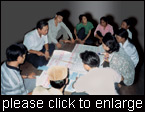InfoResources News No 5 / 04 (November
2004)
Special feature
> How can rural development projects be optimised?
Of current interest
Policy
> Trade Knowledge Network: Lessons
learned
> Ethics in forest management and development
> Mainstreaming climate risks in development
planning
> African agriculture: Hope and potential
> Forests and Water: Managing Interrelations
Implementation
> Institutionalising the participatory management of natural resources
> Non-timber forest products (NTFP) in Africa
Research
> Soil fertility – a challenge for research in Africa
> A forest reserve based on indigenous knowledge
> Coffee cooperatives: Success through fair
trade
How can rural development projects be optimised?
 Three
recent publications present methods for implementing projects in a rural
setting. Although these methods cannot solve all problems, they nevertheless
contain valuable suggestions with regard to specific issues. Three
recent publications present methods for implementing projects in a rural
setting. Although these methods cannot solve all problems, they nevertheless
contain valuable suggestions with regard to specific issues.
Participatory Innovation Development (PID)
is a process where the local rural population searches for successful
innovations together with scientists and extension workers. The idea
is to combine the local knowledge of the farmers with the formal knowledge
of the scientists and to find adequate innovations by experimenting.
PID has two main goals:
Possible results include the introduction of new crops and agricultural
techniques, as well as new forms of organisation. Based on practical
experience, a new handbook provides a down-to-earth instruction on how
to implement PID. The process is subdivided into manageable modules
covering all necessary steps, from the introduction of PID to planning
and implementation of experiments to evaluation and dissipation of results.
This handbook offers a comprehensive basis that will be especially useful
to all those who are planning to introduce PID in a project.
Rapid Market Appraisal (RMA) is a method to
better understand complex market systems within a short time. It is
primarily based on interviews with key informants such as customers,
traders, producers, and the government administration. These interviews
are complemented by personal observations and secondary sources of information.
Ideally, RMA is conducted by a multidisciplinary team of external specialists
and local stakeholders. RMA has a threefold purpose:
-
First of all, local people involved receive further training and become
more aware of market issues;
-
secondly, market information is generated to the benefit of producers
and traders;
-
and thirdly, producers are animated to join forces for marketing their
products.
RMA focuses on demand and thereby tries to counteract the frequently
onesided focus of development projects on production. A recently published
toolkit contains methods, tools, and case studies from Kyrgyzstan and
Vietnam which illustrate the fact that transmitting the method of RMA
and a basic understanding of markets to local project workers is not
an easy task, and that great attention must also be paid to the implementation
of RMA results.
Going Public is the name of a new method for
extension work with farmers in a rural setting. It makes use of public
spaces, such as markets or bus terminals, for spontaneous conversations
with a greater number of farmers. Extension workers have repeatedly
and successfully applied this method in Bolivia and in Bangladesh. Using
illustrative material, they informed farmers about the treatment of
diseases in potatoes and peaches, as well as about a new method of drying
rice. Farmers usually showed great interest and actively participated
in the demonstrations, while at the same time providing the extension
workers with valuable information. In their familiar market surroundings
the farmers were less inhibited to share their experience than in other
extension work situations. Going Public makes it possible to
reach a great number of people at a low cost. However, not all agricultural
information can be transmitted in this way, and the method requires
a great talent for communication and improvisation on the part of the
extension worker.
Sources:
> Finding new things and ways that work. A Manual for Introducing
Participatory Innovation Development (PID). U. Scheuermeier, E. Katz,
S. Heiland. Swiss Center for Agricultural Extension (LBL), Lindau, March
2004. 244 p.
www.lbl.ch/internat/services/publ/publicat/new_things/finding.htm
> Clients First! A Rapid Market Appraisal Tool Kit. Theoretical
background and experiences fromarious RMA events. Experience
and Learning in International Cooperation – Helvetas Publications, No.3.
S. Joss, H. Schaltenbrand, P. Schmidt. Helvetas, 2004, 49 p.
www.helvetas.ch/global/pdf/english/Professional_competences/
Documented_experiences/resources/Clients_First_lowres.pdf
> Going Public: A New Extension Method. J. W. Bentley
et al. in: International Journal of Agricultural Sustainability. Vol.
1, No. 2, 2003. p.108–123. (Short summary of the method:
www.new-agri.co.uk/02-2/develop/dev05.html)

Of current interest: Policy
Trade Knowledge Network: Lessons learned
”Q: Is trade good or bad for the environment? A: No.” This prosaic
and dry
statement is the heading of the first chapter of a book entitled Lessons
Learned on Trade and Sustainable Development. The book contains
a synthesis drawn from six years of research by the Trade Knowledge
Network (TKN), and represents a useful factbook both for interested
laypersons and for people who already feel at home in the debate on
trade and sustainability.
Between 1998 and 2004, research institutions in the eight TKN member
countries – Argentina, Bangladesh, Chile, China, Costa Rica, Pakistan,
South Africa, and Vietnam – conducted comprehensive national studies,
complemented by topical research at the international level. They come
to the conclusion that trade and freedom of trade are good for the natural
and social environment in some cases and bad in others, and that very
often they are both good and bad at the same time. A particular opportunity
is seen in the ”green” export market. Export of ecological products
(aquaculture, forest products, agricultural products) and ecotourism
sometimes even lead to win-win solutions, since environmental concerns
are taken into account, while at the same time generating economic growth
and opening new markets. An important prerequisite for this to happen
are strong national and international environmental and trade institutions
that are networked among each other, thus providing a basis for concerted
development and monitoring of standards.
Source: Lessons Learned on Trade and
Sustainable Development. Aaron Cosbey. IISD. Geneva, 2004. 48 p. The hard copy of the book
includes a companion CD covering all of the surveyed TKN research
(more than 40 papers in all, including several in Spanish). Download
in pdf format. www.tradeknowledgenetwork.net
Ethics in forest management and development
D. Macqueen’s article compares current international forestry negotiations
with the preparation and subsequent launch in 2000 of the Earth Charter
in the Hague. The author discusses present negotiations (IPF/IFF, UNFF)
which he considers as individualistic and materialistic, and long-term
approaches more in line with ethical principles reflecting collective
community aspirations.
His interesting and courageous argument calls for a ”silent” revolution,
which might even influence our notions of national sovereignty by introducing
a new awareness of global interdependence. His arguments appear to be
theoretical, but the author is wise enough to admit that he only wishes
to prove the legitimacy of ”forest ethics” as a legitimate object of
investigation and of a constructive future debate. His arguments are
worthy of consideration: he questions the capacity of market mechanisms
to endow forests with a similar value as other earth uses. He therefore
proposes to change our educational and value systems instead of opting
for short-term political solutions.
Source: Forest Ethics: the role of ethical
dialogue in the fate of the forests. Duncan Macqueen. Edinburgh, IIED, 2004. 20 p.
www.iied.org/docs/flu/Forest_ethics_final.pdf
Mainstreaming climate risks in development planning
Models reveal that income from agricultural activities in India will
diminish by 9 – 25% if the global temperature rises by 2 – 3.5°C.
The poorest population groups are most affected by risks related to
change climate: Their vulnerability is high, while their capacity to
cope with hazards and recover from them is low. In a set of key sheets
on climate change and poverty, the DFID recommends that climate risks
be integrated as a transversal topic in all planning of development
activities. Particular emphasis is placed on the importance of measures
at the national level. Three practical steps can help to modify national
development policies in order to enhance resilience.
- Step one: Stop and think about possible effects of climate change
on poverty reduction strategies.
- Step two: Give first priority to those issues in poverty reduction
strategies that are concerned by climate risks.
- Step three: Make targeted modifications in national strategies that
are directly affected by the climate.
The 13 key sheets are designed for use by the staff of the DFID and
its partners. The complex issue is subdivided into clear thematic aspects
such as ”The impact of climate change on the health of the poor”, ”Taking
initial steps towards adaptation”, or ”The right information can help
the poor to cope”. A concise explanation of causal connections is given
for each theme, along with concrete recommendations on measures to be
taken and frame conditions to be created at the national level.
Source: Key Sheets on Climate Change
and Poverty, DFID 2004.
www.dfid.gov.uk/pubs/files/climatechange/keysheetsindex.asp

African agriculture: Hope and potential
Due to population growth the amount of available food
per person has diminished since 1990 despite an increase in production.
Commissioned by the UN Secretary-General, researchers from the InterAcademy
Council have investigated how science and technology can contribute
to improving the situation.
Most striking among the short- and long-term measures suggested is the
somewhat problematic demand to focus on four multiple production systems
instead of the seventeen traditional systems currently in use. The group
of researchers hopes that this would lead to a massive increase in productivity
and thus raise food security in Africa, in analogy to the Green Revolution
in Asia. Further suggestions include the development of better adapted
technologies by more strongly integrating local knowledge, local production
of as much agricultural equipment as possible, and more adequate application
of conventional and biotechnological cultivation practices according
to locations. Modern information and communication technology should
be applied at all levels. Furthermore, a closer coordination of agriculture
with related sectors such as education and health is referred to as
promising. However, according to the authors, the greatest challenge
consists in making agricultural research more client- and result-oriented
by more strongly involving farmers.
Source: Realizing the Promise
and Potential of African Agriculture. InterAcademy Council (IAC) Report.
2004. 266 p.
www.interacademycouncil.net/report.asp?id=8285
Forests and Water: Managing Interrelations
 Due
to their biodiversity, forests generate a range of products and services
that are of economic, social or cultural value to human beings (see
diagram). Natural resource management provisions should ensure the creation
and maintenance of these goods and services in the long term. However,
unsustainable management practices of forests do not only generate short-term
benefits but also considerable costs for society. Payment by the beneficiaries
of the services would enable us to internalise external costs and promote
sustainable management. Due
to their biodiversity, forests generate a range of products and services
that are of economic, social or cultural value to human beings (see
diagram). Natural resource management provisions should ensure the creation
and maintenance of these goods and services in the long term. However,
unsustainable management practices of forests do not only generate short-term
benefits but also considerable costs for society. Payment by the beneficiaries
of the services would enable us to internalise external costs and promote
sustainable management.
A two-day ”Forest and water” conference on the multifunctionality of
forests, on interactions between forests and water, and sustainable
resource management, was the basis of this brochure which presents an
in-depth analysis of the information exchanged among conference participants
and the public on multifunctionality, community and institutional management,
and integrated natural resource management. The brochure focuses on
the promising though controversial issue of payments for environmental
services.
Source: Forests and Water:
Managing Interrelations. CDE Development and Environments Report no
19. S. Brüschweiler, U. Höggel, A. Kläy. Geographica
Bernensia. 2004. Pdf-files of the report can be ordered at: infoservice@cde.unibe.ch

Of current interest: Implementation
Institutionalising the participatory management of natural resources
This was the aim of a regional sustainable development program implemented
by the Mexican environmental ministry between 1996 and 2000. Its objectives
targeted rural poverty alleviation, the promotion of social wellbeing
and a cutdown on environmental deterioration.
Of dreams and shadows relates the experiences of this program,
and shows its evaluation by means of an analytic grid of participatory
policies. To what extent can a governmental institution set up and manage
participatory regional management policies? This requires fundamental
behavioural changes within the governmental administration system; these
are difficult to bring about during the six years constituting the usual
presidential term. Questions related to time and to the necessary interactions
between an analysis, an understanding and the transformation of governmental
institutions are seen as necessary stages of a learning organisation.
This approach is interesting in that it accounts for interactions between
players in such a program, for the social networks in which they participate,
and for communication between them. All these aspects are necessary
to instill a climate of confidence towards the local administrative
authorities in charge of participatory sustainable development policies.
Source: Of Dreams and Shadows: seeking
change for the institutionalisation of participation for natural resource
management. Jutta Blauert and Kristina Dietz. Brighton, IDS, 2004. 60
p.
www.iied.org/docs/sarl/IIED_IP7_Mexico.pdf
Non-timber forest products (NTFP) in Africa
 A
program conducted worldwide by CIFOR comparing non-timber forest products
gave rise to 3 publications, one for each continent: Asia, Africa, Latin
America. Especially in Africa this study enabled researchers to escape
their isolation and view their work in a global perspective. A
program conducted worldwide by CIFOR comparing non-timber forest products
gave rise to 3 publications, one for each continent: Asia, Africa, Latin
America. Especially in Africa this study enabled researchers to escape
their isolation and view their work in a global perspective.
Generally speaking, the interest for NTFP has grown, due to the part
they play in poor rural regions (food, income). In Africa, the sustainability
of these resources depends to a large extent on access and property
rights, as well as on dynamic and diversified local economies. The great
diversity of NTFP, and their production in highly variable environmental
and socio-ecological contexts makes this a complicated issue.
For example, the plant Harpagophytum or ”devil’s claw foot”
from the Kalahari region has excellent anti-inflammatory properties
for the treatment of arthritis and rheumatism. The study shows that
if the above-mentioned conditions were accounted for, and local communities
were better organised, this plant could be harvested in the long term,
providing important benefits without entailing over-exploitation.
Source: Forest Products, Livelihoods
and Conservation,
Vol. 1: Asia. Koen Kusters and Brian Belcher (eds.). CIFOR,
2004. 365 p. www.cifor.cgiar.org/publications/pdf_files/Books/
NTFPAsia/TOC-Chapter5.PDF
Vol. 2: Africa. Terry Sunderland and Ousseynou Ndoye (eds). CIFOR,
2004. 333 p. www.cifor.cgiar.org/publications/pdf_files/Books/
NTFPAfrica/TOC-Chapter6.PDF
Vol. 3: Latin America (publication foreseen).

Of current interest: Research
Soil fertility – a challenge for research in Africa
Soil fertility degradation remains one of the chief problems for food
production in sub-Saharan Africa. Taking a holistic approach that increasingly
involves socioeconomic aspects in addition to physical aspects, researchers
from the African Network for Soil Biology and Fertility are
jointly searching for solutions. This recently published book contains
a collection of essays on integrated soil fertility management,
soil biological diversity, but also on questions related to participatory
research and implementation of findings.
Along with numerous descriptions of field experiments there are also
contributions that ponder the role and purpose of research in general.
For example, one contributor points out how difficult it is, particularly
in the African context, to take into account the socio-economic view.
If research is to produce implementationoriented results, scientists
will have to broaden their horizons, and farmers will have to be more
closely involved. Experience shows that soil fertility is strongly influenced
by social and economic conditions. Often, farmers are unable to cultivate
their land the way they would actually like to due to various constraints.
Source: Managing Nutrient
Cycles to Sustain Soil Fertility in Sub-Saharan
Africa. André Bationo (Ed.). Academy Science Publishers / Tropical
Soil Biology and Fertility Institute of CIAT. Nairobi, 2004. 608 p.
www.ciat.cgiar.org/tsbf_institute/book_mgmt_nutri_cycles.htm
A forest reserve based on indigenous knowledge
An approach based on the linking of ”global” services generated by
forests and the satisfaction of individual interests is a major challenge for
forestry. In Ecuador, ”exchange” between traditional and so-called scientific
knowledge has proven to be a successful factor for the set-up of the
first, community-managed forest conservation reserve.
Studies of the forest’s capacity to ”seize the fog” have demonstrated
its positive impact on the region’s water status, putting into doubt
the local ”utilitarian” view of forests. Local communities have gradually
admitted that fog is not only a cause of illness and discomfort. In
conjunction with the forest and science it may provide irrigation solutions
for flatland farming. Local knowledge and traditional means of oral
communication, as well as common law regulations concerning access to
public property have been successfully put to use to manage these newly
privatised watershed areas.
Source: Synergy Between Traditional Ecological
Knowledge and Conservation Science Supports Forest Preservation in Ecuador.
C. Dustin Becker, Kabita Ghimire. In: Conservation Ecology, vol. 8 (2003)
no 1. 12 p. www.ecologyandsociety.org/vol8/iss1/art1/
Coffe cooperatives: Success through fair trade
 Many
development agencies and NGOs encourage and financially support small-scale
coffee producers to join in cooperatives. In her study, the author certifies
these cooperatives as generally having a stronger market position and
a higher potential for innovation, and as strengthening both empowerment
and social participation of their members. However, she also points
out the dangers of lacking ownership, free riding, or cumbersome internal
structures, which can develop due to the above-mentioned ”subsidising”. Many
development agencies and NGOs encourage and financially support small-scale
coffee producers to join in cooperatives. In her study, the author certifies
these cooperatives as generally having a stronger market position and
a higher potential for innovation, and as strengthening both empowerment
and social participation of their members. However, she also points
out the dangers of lacking ownership, free riding, or cumbersome internal
structures, which can develop due to the above-mentioned ”subsidising”.
In the second part of her paper, the author concludes from a case study
in Chiappas that successful cooperatives profit significantly from additional
income through fair trade and organic production. However, she also
states that in order to do so, a cooperative must have well-functioning
internal structures.
Organisational strengthening of cooperatives combined with additional
income through fair trade can thus contribute to poverty alleviation
in coffeegrowing areas of the South. In order to promote the realisation
of this potential, the author demands further research into stories
of success and failure of cooperatives. In order to counter global overproduction
and price decline, however, we would have to completely rethink the
international system of coffee trade.
Source: Coffee, Co-operatives and Competition:
The Impact of Fair Trade. Anna Milford. CMI Reports, R 2004: 6. Bergen,
2004. 83 p.
www.cmi.no/publications/2004/rep/r2004-6.pdf

|




